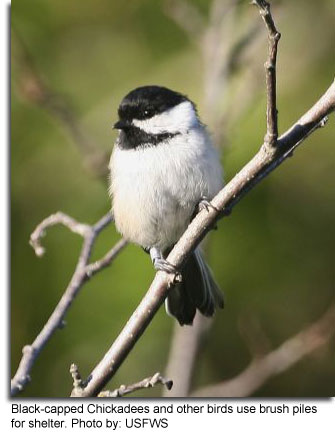Proper wildlife habitat requires four main components: food, water, shelter and space. Shelter is a very important element which is often limited in backyard habitats. One way to provide additional shelter for wildlife is to create a brush pile. Brush piles are a deliberate collection of brush or branches, sticks and other plant parts placed over a supporting base or foundation.
Why are Brush Piles Important?
When naturally sheltered places are removed for crops or for construction, brush piles can help to replace them and can serve many of the needs that wild animals have for dense cover. All wildlife species need dense cover throughout the year for several reasons:
- Shelter from predators
- Shelter from severe weather
- Shelter for safe corridors
- Places to rest

Where Should Brush Piles be Built?
Though brush piles will be used by wildlife almost anywhere, there are certain areas where they are most helpful to the animals:
- Forest edges and forest openings
- Field corners and edges
- On the margin between a stream and a marsh
- Near land that is being cleared
- Near forests that are being thinned
- Partially submerged along pond edges
In areas cleared of natural wildlife cover, it is best to build at least three or four brush piles per acre. To help conceal wildlife traveling along woodland borders, place a brush pile every 200 to 300 feet. The best brush piles are located no more than 10ft from a woodland border. Brush piles can also be located near gardens to entice bug-munching birds.
How to Build a Brush Pile
A finished brush pile should be at least ten to 15 feet wide and 25 feet long. It should be dense enough to protect the animal while still allowing wildlife to easily run inside. However, smaller brush piles can be of benefit to birds, lizards, chipmunks, and other small animals. A brush pile has two parts:
Supporting Base
The base is formed from two layers of logs, evenly spaced, to allow easy access. Within the base, you can also put drainage pipes, or tiles, cinder blocks, or tires with holes cut along the tread. Animals may use these as dens.
- Build the base of the brush pile over stones, tires, cinder blocks or other durable material to slow the decay of the log base.
- Place alternate layers of logs at right angles to one another to form the base. These logs should be at least six inches in diameter and spaced six to ten inches apart. The base will look similar to a log cabin.
- Rot resistant wood like cedar, locust or other hardwoods make the best base. Stay away from treated wood for your base.
Pile of Plant Material on Top
The “brush” part of the pile can be made from a variety of plant parts, including old Christmas trees.
- Place the small trees, branches, and other brush over the base using enough material to form a tepee or mound-shaped pile about five feet tall.
- Pile the brush on the base so that the center is very dense, but the edges are loose. This will shelter the animals and still allow them to easily come and go.
- Replace material as it decays

Take note: Though brush piles are tremendously beneficial to wildlife, they can also attract woodchucks, skunks, and snakes, all of which may become household pests. Because of this, it is best to keep brush piles away from your home. Brush piles may also conceal predators, so it is also good to keep them away from bird feeders located on or near the ground. Also be aware of local and community ordinances before creating a brush pile habitat.
Invite Wildlife to Your Backyard!
For more information, please contact:
Maryland Department of Natural Resources
Wildlife and Heritage Service
Tawes State Office Building, E-1
Annapolis MD 21401
410-260-8540
Toll-free in Maryland: 1-877-620-8DNR
[email protected]
Acknowledgements:
- Black-capped Chickadee photo by: USFWS